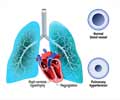Elevated IL-26 levels in nasal lavage have been identified as a potential early diagnostic tool for COPD, offering a simple method to assess the disease and improve treatment strategies.

Nasal production of IL-26 involving T cells in smokers with and without COPD
Go to source). Chronic obstructive pulmonary disease affects ten percent of the population and is the fourth most common cause of death in the world. The disease is mainly caused by smoke from biomass and the patient group is very heterogeneous in terms of symptoms and prognosis.
This means that the medical needs vary greatly, while today's examination methods are neither sufficient nor useful for assessing the large number of patients. Therefore, simple and safe methods that work at the individual level are needed.
‘Did You Know?
Right handed people appear to breathe more through their left nostril. #medindia #nose #breathing’





Right handed people appear to breathe more through their left nostril. #medindia #nose #breathing’
Advertisement
Early Detection of COPD Through Nasal Protein Analysis
Researchers at Karolinska Institutet and Karolinska University Hospital have now shown that elevated levels of the protein interleukin-26 (IL-26) in the nose of smokers with and without COPD can be used to assess patients with an early phase of the disease.IL-26 is a so-called cytokine that is important for cell communication in the immune system. An interesting property of IL-26 is that this cytokine has a direct inhibitory effect on bacteria and viruses.
Cytokines can influence inflammation and immune responses, and IL-26 has previously been linked to various inflammatory diseases, including COPD. In COPD, the levels of IL-26 in the lower respiratory tract have been shown to be elevated.
In the current study, the researchers have focused on understanding how IL-26 is produced in the nose of smokers and what the levels say about the individual COPD patient.
Advertisement
Smokers with COPD Show Higher IL-26 Levels
“We have discovered that IL-26 is produced in greater amounts in the nose of smokers with COPD compared to non-smokers, while smokers without COPD showed a tendency towards increased levels. This suggests that IL-26 may be an important factor in the inflammatory process underlying COPD,” says the study's first author Julia Arebro, researcher at the Department of Clinical Science, Intervention and Technology, Karolinska Institutet, and physician at Karolinska University Hospital.The study included 50 research participants; active habitual smokers with and without COPD, as well as a control group of healthy non-smokers. Patients with other lung diseases were excluded from the study.
Nasal Lavage as a Diagnostic Tool for COPD
Among other things, the study participants underwent a simple nasal lavage so that the researchers could analyse the presence of IL-26 in the nose. The measured levels were found to reflect inflammation of the lower respiratory tract but also symptoms and other clinical findings in COPD.“This opens up an easier way to characterise COPD patients without having to examine their lower airways with methods that are resource-intensive and involve medical risks,” says Julia Arebro.
White Blood Cells Linked to IL-26 in COPD Inflammation
The study also shows that T cells, a type of white blood cell in the immune system, are involved in the production of IL-26 in the nose.“Our results support that IL-26 contributes to the chronic inflammation that is typical for COPD. This may open up for new treatment strategies that target IL-26 to reduce inflammation and improve the quality of life for patients with COPD,” says Anders Lindén, professor at the Institute of Environmental Medicine, Karolinska Institutet, and senior physician at Karolinska University Hospital who has led the research team behind the study.
The study was conducted in patients with mild to moderate COPD. In a next step, the researchers are planning a similar study on COPD, but in later stages. If future work confirms current results, the researchers believe that the method for easily estimating patients with COPD can be implemented within the next few years.
Reference:
- Nasal production of IL-26 involving T cells in smokers with and without COPD - (https://www.jacionline.org/article/S0091-6749(25)00332-X/fulltext)
Source-Eurekalert















